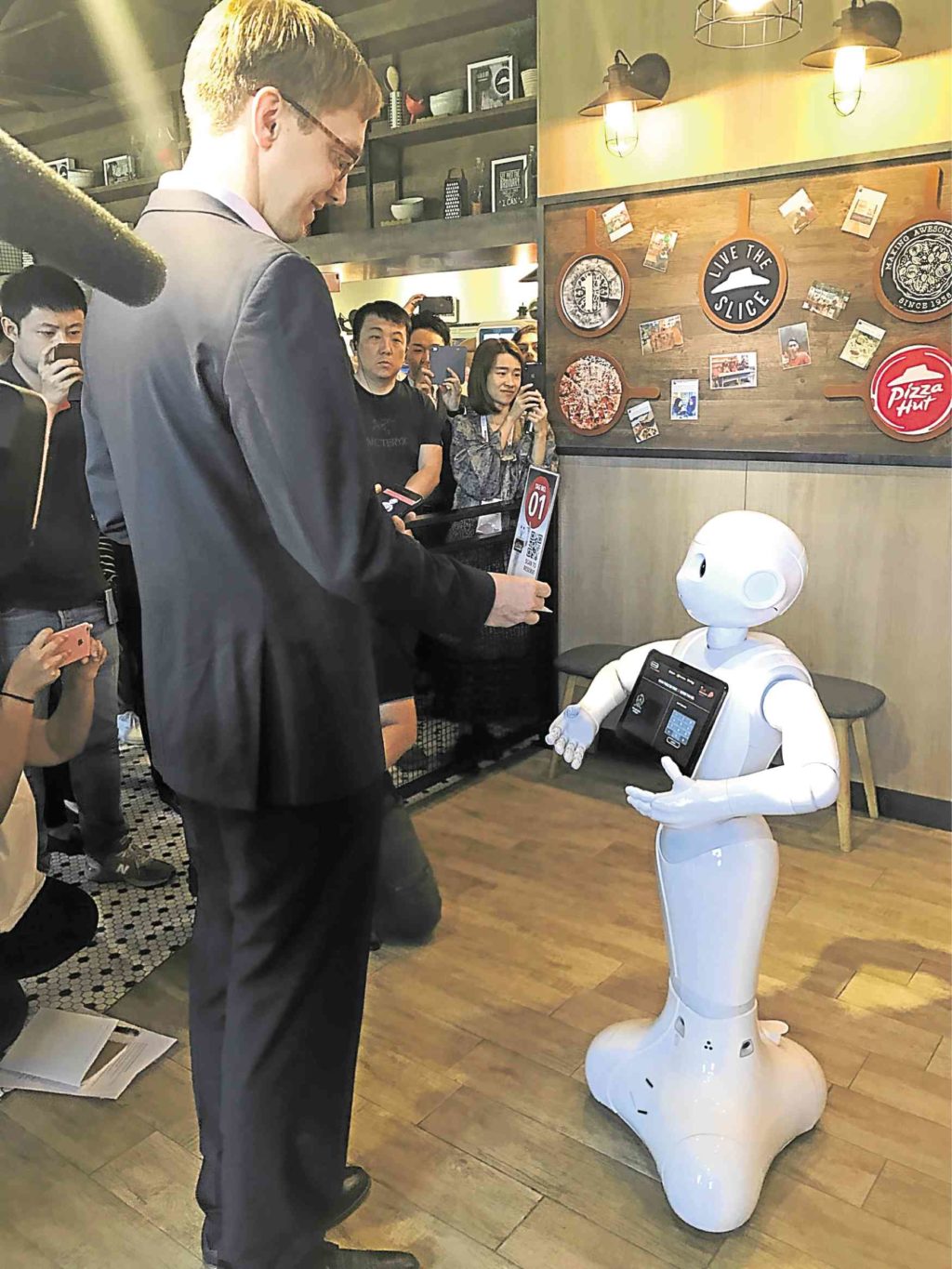Want pizza? Ask Pepper the robot

Tobias Puehse, vice president for innovation management, digital payments and labs at Mastercard, interacts with Pepper, the humanoid robot.
SINGAPORE—Don’t be surprised if a humanoid robot suddenly takes your order the next time you drop by your favorite pizza parlor.
Global payments technology firm MasterCard recently marked a new frontier in payments with the recent launch of the first voice-based commerce application for a humanoid robot.
Developed by Softbank Robotics and powered by MasterCard’s Connected Device API (Application Programming Interfaces), the humanoid robot, named Pepper, did not only help diners at the Pizza Hut Singapore’s Punggol outlet with their menu choices, it also enabled them to make fast, simple yet secure digital payments using MasterPass, a mobile payment platform that is linked to their smart devices.
The idea aims to give consumers an additional payment choice that is readily available on all types of digital interaction points without compromising on security and personalization, as well as reduce the waiting time for customers, particularly in restaurants where high turnover is needed, according to Tobias Puehse, vice president, innovation management, digital payments and labs at MasterCard.
Similarly, he added, MasterCard also aims to help restaurants and stores add more value to each transaction by making it faster and simpler to connect to any new voice and chatbot interface without major backend integration.
“We’re actually trying to create experiences that are digital, where the solution is so smart, uses artificial intelligence and technology that become adjusted to us humans,” he said.
In taking a step into the realm of conversational commerce, Puehse said the company also worked with Teksbotics, a robotics and artificial intelligence firm, to link the robot’s voice-based interface technologies with MasterCard’s own secure payment services.
He explained that the integration of Masterpass—Mastercard’s digital payments solution—into its Connected Device API means consumers have the added convenience of now being able to pay across a number of different interfaces—whether via digital voice-based assistants, social media chatbots and mobile apps.
“The result is a safe and easy voice-assisted commerce experience with the potential to be adopted across various environments—from retail to restaurants and beyond,” he said.
However, Puehse said Pepper’s services were only on a trial basis.
“The robot is only available today commercially for purchases in markets like Japan … but these kinds of innovative technologies will definitely proliferate. For MasterCard, a humanoid robot is one of the many things that’s going to be out there,” he said.
Apart from the seamless voice-based commerce experience brought by Pepper, MasterCard also provided businesses and consumers a glimpse of what the future of payments looks likes at the firm’s revolutionary booth at the recent Asian edition of Money 20/20, the world’s largest payments and financial services event.
Among these are the Masterpass QR, a new electronic payment option that allows customers to pay directly from their mobile phones without handing over their cards during payment.
Merchants only need a QR code to accept payment, while banks can take advantage of Masterpass QR’s easy integration into their existing mobile apps.
On the other hand, MasterCard Digital Enablement Service (MDES) helps transform any connected device into a commerce device to make and receive payments.
According to the MasterCard website, the service allows issuers and merchants to manage tokenization and digitization to create EMV-like security for every transaction.
“It gives cardholders the choice and peace of mind to make more secure digital payments from a variety of connected devices through a tap, touch or click,” it added.
Another payment option presented by MasterCard was the NuDetect, which provides consumers and businesses a solution to help address potential cyber and device-specific threats.
The service “continuously verifies a users’ online identity by authenticating the user based on their natural interactions online—behavior that can’t be mimicked or replicated by a third party,” according to MasterCard.
The solution harnesses behavioral and biometric analysis to help clients predict fraud and risk.
It accurately identifies the authentic good user behind the device and builds a detailed contiguous profile of the user based on how he or she interacts with online services using devices, it added.
“There have been more innovative technologies in the past five years than the last five decades. Within the realm of payments, technology has enabled big changes in how consumers spend and merchants run their businesses,” said Puehse.
MasterCard, he said, is constantly tinkering and engineering new ways for clients “to live in an intuitive, inclusive and imaginative world without boundaries.”
